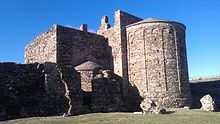Santa Maria de Roses
The old Benedictine monastery of Santa Maria de Roses ( Catalan : Monestir de Santa Maria de Roses ) is a Romanesque monastery ruin that was built and inaugurated in 1060/1061 as a Benedictine monastery on the area of the citadel of Roses in Roses on the ground of a pre-Romanesque church. The Romanesque monastery church was built as a three-aisled basilica .
The origins of the monastery of Santa Maria de Roses go back to a private church foundation by Count Gausfred von Empuries, Perelada and Rosseló in 944. In such "private churches" of nobles and powerful people the cult was performed, but they were withdrawn from church administration. In the year 948 this church is shown as belonging to the monastery of Sant Pere de Rodes in documents .
In 1938, a Christian altar stone made of marble was discovered in the central arch of the Romanesque building from the 11th century. Texts relating to the period from 950 to 954 were engraved on the back of this stone. It is described in these texts that Count Sunyer of Barcelona chose the church as his final resting place. The text shows that this church was in good general and structural condition in the middle of the 10th century. From 960 the church was demonstrably raised to the rank of a monastery and a monastic community was established. For reasons not yet known, however, the building became dilapidated.
The decision to settle a community of monks set a process in motion that upheld the cult despite all structural and organizational difficulties. This process culminated in the 11th century church rebuilding of the basilica in the Lombard-Romanesque style, which has come down to us as a ruin. In 1060/61 the new basilica was inaugurated as a Benedictine monastery church. The city of Roses , which is mentioned for the first time in 1079 , also emerged in the vicinity of this monastery . The monastery began to fall apart in the 15th century. In 1588 the monks left the monastery because of a plague epidemic, which was then completely robbed. In 1792 the few monks who had remained until then left the monastery and church before the French attacked. In 1793 the French destroyed the facility. The ancient nucleus of the monastery complex was currently being reconstructed and excavation and cleaning work was being carried out on the monastery church.
literature
- Joan Badia i Homs: Gran Geografia Comarcal De Catalunya. Volume 4: L'Alt Empordà, El Baix Empordà, 1st edition, Barcelona 1981 (Enciclopèdia Catalana SA) ISBN 84-85194-19-5 , pp. 270-280, article “Roses”, there also “Santa Maria de Roses ". (Catalan)
- Joan Carreras i Martí: Gran Enciclopèdia Catalana. Volume 12, 1st edition Barcelona 1978, Enciclopèdia Catalana SA, ISBN 84-85194-07-1 , S, p. 754, article “Roses, monestir de”. (Catalan)
- Carlos Díaz, Hug Palou, Anna Ma. Puig: La Ciutadella de Roses. 2nd edition, 2004, ISBN 84-86812-79-8 , p. 38.f, “El Monestir de Sta. Maria". (Catalan)
Web links
Coordinates: 42 ° 16 ′ 3.9 " N , 3 ° 10 ′ 12.9" E


